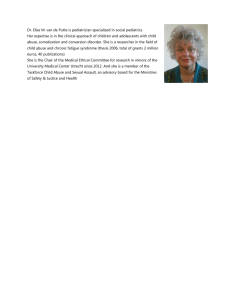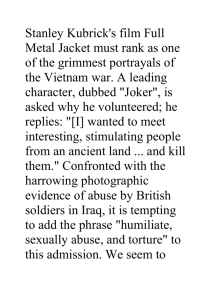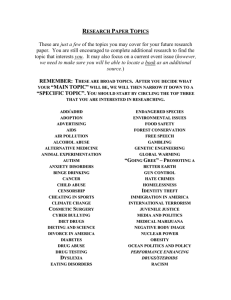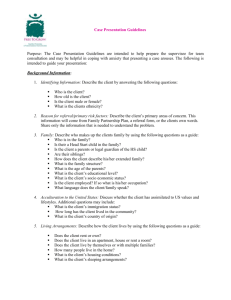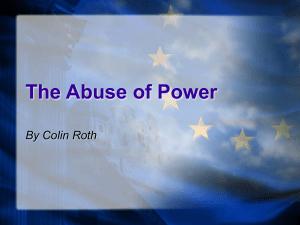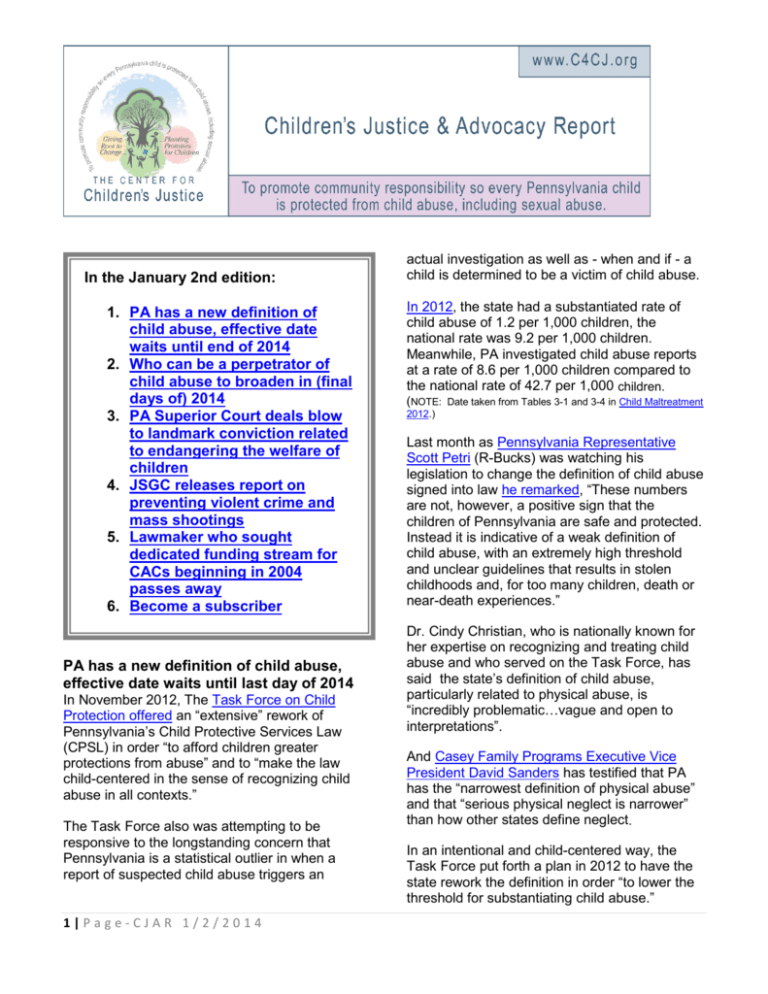
In the January 2nd edition:
1. PA has a new definition of
child abuse, effective date
waits until end of 2014
2. Who can be a perpetrator of
child abuse to broaden in (final
days of) 2014
3. PA Superior Court deals blow
to landmark conviction related
to endangering the welfare of
children
4. JSGC releases report on
preventing violent crime and
mass shootings
5. Lawmaker who sought
dedicated funding stream for
CACs beginning in 2004
passes away
6. Become a subscriber
PA has a new definition of child abuse,
effective date waits until last day of 2014
In November 2012, The Task Force on Child
Protection offered an “extensive” rework of
Pennsylvania’s Child Protective Services Law
(CPSL) in order “to afford children greater
protections from abuse” and to “make the law
child-centered in the sense of recognizing child
abuse in all contexts.”
The Task Force also was attempting to be
responsive to the longstanding concern that
Pennsylvania is a statistical outlier in when a
report of suspected child abuse triggers an
1|Page-CJAR 1/2/2014
actual investigation as well as - when and if - a
child is determined to be a victim of child abuse.
In 2012, the state had a substantiated rate of
child abuse of 1.2 per 1,000 children, the
national rate was 9.2 per 1,000 children.
Meanwhile, PA investigated child abuse reports
at a rate of 8.6 per 1,000 children compared to
the national rate of 42.7 per 1,000 children.
(NOTE: Date taken from Tables 3-1 and 3-4 in Child Maltreatment
2012.)
Last month as Pennsylvania Representative
Scott Petri (R-Bucks) was watching his
legislation to change the definition of child abuse
signed into law he remarked, “These numbers
are not, however, a positive sign that the
children of Pennsylvania are safe and protected.
Instead it is indicative of a weak definition of
child abuse, with an extremely high threshold
and unclear guidelines that results in stolen
childhoods and, for too many children, death or
near-death experiences.”
Dr. Cindy Christian, who is nationally known for
her expertise on recognizing and treating child
abuse and who served on the Task Force, has
said the state’s definition of child abuse,
particularly related to physical abuse, is
“incredibly problematic…vague and open to
interpretations”.
And Casey Family Programs Executive Vice
President David Sanders has testified that PA
has the “narrowest definition of physical abuse”
and that “serious physical neglect is narrower”
than how other states define neglect.
In an intentional and child-centered way, the
Task Force put forth a plan in 2012 to have the
state rework the definition in order “to lower the
threshold for substantiating child abuse.”
House Bill 726, which was signed into law (Act
108) on December 18th by Governor Tom
Corbett, translates nearly two decades of
concerns as well as the Task Force’s
recommendations into a law that should now be
more child-centered and prevention-focused.
Current Pennsylvania law, which will remain in
effect until December 31, 2014, defines “serious
physical injury” as an injury to the child that
caused them to experience “severe pain” or
“significantly impairs a child’s physical
functioning,
either
Pennsylvania children
were child abuse victims in
temporarily or
2012.
permanently.”
Determining
In 2012, PA had a
whether the
substantiated rate of child
abuse of 1.2 per 1,000
“severe pain”
children, the national rate
threshold was
was 9.2 per 1,000 children.
met, as a result
PA investigation rate was
of the injuries,
8.6 per 1,000 children
has invited its
compared to the national
rate of 42.7 per 1,000
own set of
children.
nuances and
complications.
The Task Force recommended and Act 108
advances the lowering of the threshold for what
constitutes child abuse from serious bodily injury
to bodily injury.
Bodily injury is defined as “Impairment of
physical condition or substantial pain.”
Meanwhile, seriously bodily injury is defined as
an injury “which creates a substantial risk of
death or which causes serious, permanent
disfigurement, or protracted loss or impairment
of the function of any bodily member or organ.”
Under current law, allegations involving a
“serious physical injury” opens the door, but
doesn’t require, that the child receive an
examination by a certified medical practitioner.
However, another bill signed by Corbett on
December 18th – Senate Bill 1116 known now as
Act 123 of 2013 – invites such an exam when an
investigation of a report of suspected child
abuse “indicates bodily injury.”
More expansive language to again encourage,
but not require, medical exams for other children
2|Page-CJAR 1/2/2014
living in the home with the child suspected to be
abused or in situations where there is a
suspected “history” of neglect were eventually
taken out of Senate Bill 1116 before Corbett
signed it into law.
Included in the reworked definition of child
abuse includes “intentionally, knowingly or
recklessly” causing bodily injury by “any recent
act or failure to act.” Also included is
“fabricating, feigning or intentionally
exaggerating or inducing a medical symptom or
disease which results in a potentially harmful
medical evaluation or treatment to the child
through any recent act.”
There are important modifications to the
definition of “serious physical neglect” providing
clarification that a child can be the victim of this
type of neglect as a result of a singular event.
Current law defines “serious physical neglect” as
that which constitutes “prolonged or repeated
lack of supervision or the failure to provide
essentials of life, including adequate medical
care, which endangers a child’s life or
development or impairs the child’s functioning.”
Included in the future will be “any of the following
when committed by a perpetrator that endangers
a child’s life or health, threatens a child’s wellbeing, causes bodily injury or impairs a child’s
health, development or functioning:
(1) A repeated, prolonged or unconscionable
egregious failure to supervise a child in a
manner that is appropriate considering
the child’s developmental age and
abilities.”
The definition of child abuse overall also
includes a list of per se acts, although not as
extensive as the Task Force had recommended.
In the per se list a specific injury or level of injury
is not required to determine child abuse rather
the act itself against a child can be substantiated
as child abuse.
For instance, engaging in an act of “kicking,
biting, throwing, burning, stabbing or cutting a
child in a manner that endangers the child” is
included as a per se act of child abuse.
Additionally, “unreasonably restraining or
confining a child, based on consideration of the
method, location or duration of the restraint or
confinement.” Also, “forcefully” shaking a child
under the age of one or “forcefully slapping or
otherwise striking” a child under one are
included in the per se elements of this new
definition. Finally, having a child present at a
location where a methamphetamine lab is being
operated and “being investigated by law
enforcement” as well as leaving a child
“unsupervised” with an individual (other than the
child’s parent) who is subject to registration as a
result of a serious sexual offense are included
on the per se list.
Current exclusions from child abuse are largely
intact and expanded, including a parent’s right to
reasonably discipline a child.
The legislation did alter the religious exemption
whereby a child can be denied “needed medical
or surgical care because of sincerely held
religious beliefs.”
House Bill 726 removed that the exception can
be claimed by a “person responsible for the
welfare of the child” in addition to the child’s
parent or guardian. Also guardian is changed to
a “relative within the third degree of
consanguinity and with whom the child resides.”
The final revision to this section of the Child
Protective Services Law (CPSL) is that the
exemption will not be applicable “if the failure to
provide needed medical or surgical care causes
the death of the child.”
Before signing House Bill 726 into law, Governor
Corbett remarked that enhanced protections will
materialize only if the law is “enforced and
followed.” He also acknowledged that there is a
need for a good deal of training and education to
have the changes be realized in a protective
way for our children noting this might require
some additional funding from the state.
Powerful as the ramifications from the
Governor’s signature are so too was there
power and passion in his words and actions at
the bill singing.
He assured, with emotion, that placing his
signature on House Bill 726, Senate Bill 23 and
other child protection measures would be a
“highlight” when he looks back on his
3|Page-CJAR 1/2/2014
professional career observing what he did with
the power when he had it.
Who can be a perpetrator of child
abuse to broaden in 2014
Under current Pennsylvania law – the Child
Protective Services Law - a parent, a paramour
of a parent, an individual (over the age of 14)
living in the same home as the child, or a person
responsible for the welfare of a child can be
considered a perpetrator of child abuse.
Beyond this limited definition of who can be a
perpetrator, substantiating child abuse in PA
also requires that a child welfare investigation
determine the specific person(s) responsible for
the abuse.
In situations where the exact perpetrator(s) was
unknown (e.g., the child was in the care of
multiple caregivers over a period of time in
which medical examination suggests when the
injuries could have occurred) or even based on
case law where there have been multiple
alleged perpetrators, cases have been
unfounded. And practice varies from county-tocounty. At times the practice might be to
indicate all of the alleged perpetrators while in
other counties it might be to indicate none and
list the case as unfounded.
Pennsylvania children who have suffered broken
bones, been sexually abused or diagnosed with
abusive head trauma are among the cases
where abuse was not substantiated, the child
determined not to be a victim of child abuse,
because the perpetrator was undetermined.
These victims and the injuries they experienced
are therefore are often not represented in official
statistics by the Commonwealth. There have
also long been fundamental questions about the
reliability of statistics as well as how this status
then impacts a child’s pathway to treatment and
services.
On December 18th, Governor Corbett signed
Senate Bill 23 (Act 117 of 2013) broadening the
definition of who can be a perpetrator.
Senator Lisa Baker (R-Luzerne, Monroe), who
was the prime sponsor of Senate Bill 23,
described her legislation and the rework of how
child abuse is defined as “needed and well
considered responses to some of the hardest
and saddest situations our society must
confront.” And she stressed that the definition of
perpetrator needed to change because “It is the
immoral and illegal act that constitutes the
offense not the relationship between the abuser
and victim.”
In 2012, the Task Force sought to expand the
definition of perpetrator to include:
•
•
•
•
•
•
Employees or volunteers who have direct
or regular contact with a child as a result
of involvement in programs, services or
activities such as: camps, athletic
programs, enrichment programs and
troops.
School teachers and employees
Persons employed in programs, activities
or services which includes enrichment
and other programs, clubs and coaches.
Any person present in the child’s home
when the alleged abuse occurred.
An individual related to the child by birth,
marriage or adoption to the fifth degree.
Former paramours of a child’s parent
and former step-parents.
Senate Bill 23 now Act 117 of 2013 defines a
“perpetrator” going forward as:
•
•
•
•
•
•
A parent of the child;
A spouse or former spouse of the child’s
parent;
A paramour or former paramour of the
child’s parent;
A person 14 years of age or older and
responsible for the child’s welfare;
An individual who is 14 years of age or
older who resides in the same home as
the child;
An individual 18 years of age or older
who does not reside in the same home
as the child but is related within the third
degree of consanguinity or affinity by
birth or adoption to the child.
The legislation also provides for a distinction in
the definition for those that can be “considered a
perpetrator for failing to act” to include:
•
•
A parent of the child;
A spouse or former spouse of the child’s
parent;
4|Page-CJAR 1/2/2014
•
•
•
A paramour or former paramour of the
child’s parent;
A person 18 years of age or older and
responsible for the child’s welfare; or
An individual who is 18 years of age or
older who resides in the same home as
the child.
The bill alters the definition of a “person
responsible for the child’s welfare” to include
“any such person who has direct or regular
contact with a child through any program,
activity or service sponsored by a school, forprofit organization or religious or other not-forprofit organization.”
“Program, activity or service” isn’t defined in
Senate Bill 23. It is defined, however, in Senate
Bill 21 which is the bill sponsored by Senator
Kim Ward (R-Westmoreland) providing for
significant changes to how child abuse is
reported that has yet to be finalized by the
General Assembly.
When the Task Force unveiled its
recommendations in 2012, Chairman David
Heckler stressed that the Task Force intended to
make it clear “that persons in Sandusky’s
position are recognized as perpetrators of child
abuse under the Child Protective Services Law.”
Finally the perpetrator issue was addressed as
well in the definition of child abuse bill signed by
Corbett (House Bill 726). Once the new law is
effective, a report can be indicated as a case of
child abuse, a child determined to be a victim
“regardless the number of alleged perpetrators”
or if the perpetrator is “unknown.” In the case of
unknown perpetrators, substantiation could
occur “if substantial evidence of abuse by a
perpetrator exists, but the department or county
agency is unable to identify the specific
perpetrator.”
PA Superior Court deals blow to
landmark conviction related to
endangering the welfare of children
In 2006, child advocates along with law
enforcement fought to clarify and strengthen the
state statute that defined and graded the offense
of Endangering the Welfare of Children
(EWOC).
Today journalists and legal experts, in the wake
of a December 26th PA Superior Court decision,
are debating whether the 2006 changes were in
fact a substantial change to whom and how
EWOC was applied or whether the changes
were merely a clarification. In many ways the
change was both providing a distinct clarification
to the law, but in providing the clarification the
law was also strengthened to more fully and
firmly hold perpetrators accountable.
The December 26th Superior Court decision
reversed the EWOC conviction of and ordered
released Monsignor William Lynn, who was a
high ranking official with the Archdiocese of
Philadelphia prior to his conviction and
incarceration.
Lynn, his legal team and staunch supporters
have asserted from moment one that the case
brought against him did not involve conduct that
was within the reach of the pre-2007 EWOC
statute (the law was changed in 2006 but only
effective in 2007).
Prior to the EWOC changes effective in 2007,
the law defined the offense when “a parent,
guardian, other person supervising the welfare
of a child under 18 years of age commits an
offense if he knowingly endangers the welfare of
the child by violating a duty of care, protection or
support.” Post the change, the offense now
included “a person that employs or supervises” a
person “supervising the welfare of a child under
18 years of age.” The change was not
retroactive.
Between 1992 and 2004, Lynn was the
Secretary for the Archdiocese, which included a
wide range of duties including “handling clergy
sexual abuse issues.” While he did not have
“direct authority to transfer, remove or even
restrict the nature of a priest’s ministry,” he was
the “sole ‘funnel’ for information concerning
clergy sex abuse, and it was his office alone that
could pass on vital information about priests and
their young victims up the chain of command.”
Lynn was initially charged with two counts each
of EWOC and conspiracy to commit EWOC
connected to the supervision of two priests –
one of whom pled guilty to involuntary deviate
sexual intercourse and conspiracy to commit
EWOC in March 2012. Lynn was later convicted
5|Page-CJAR 1/2/2014
on the EWOC charge related to the priest who
pled guilty. He was acquitted of the other
EWOC change as well as the conspiracy related
charge. He was sentenced in July 2012 to
incarceration for 3 to 6 years.
He appealed his conviction asking the court to
review ten questions including whether the preamended version of EWOC “did not properly
apply” to Lynn because he was not a “parent,
guardian or other person supervising the welfare
of a child” and he “had no direct involvement
with the child, never met and never knew the
child.”
Lynn and his legal team challenge that the preamended EWOC statute imposed criminal
liability only on those persons directly
supervising children with it limited in its
application to “parents and parental surrogates.”
In the court’s opinion they write that “In essence,
he argues that the legislature’s inclusion of the
‘or a person that employs or supervises such a
person’ language….indicated an intent to add a
class of persons not originally subject to liability
under the pre-amended version.”
The Commonwealth, on the other hand and
those who believe that Lynn’s conviction was
justifiable and just, assert that the plain meaning
of the law pre-2007 captured the class of
persons specifically included with the statutory
change and thus the legislative action then was
a mere clarification versus a significant change
in intent, applicability and liability.
At trial the difference between a “person
supervising the welfare of a child” and a
“supervisor of a child” was determined to be
“syntactically small, but far from trivial.”
In its opinion, the Superior Court noted that it nor
the PA Supreme Court (pre-2007 EWOC
changes) “has ever affirmed a conviction where
the accused was not actually engaged in the
supervision of, or was responsible for
supervising, the endangered child.” The court
also reinforced that prior court decisions (Halye,
719 A.2d at 765) are “unmistakable” that “actual
supervision of children to be an element of the
offense of EWOC.”
In its decision, the three justices of the Superior
Court wrote, “We cannot dispute that the
Commonwealth presented more than adequate
evidence to sufficiently demonstrate that
Appellant prioritized the Archdiocese’s
reputation over the safety of potential victims of
sexually abusive priests...” However, they
continue that the question of Appellant’s
priorities and whether they “were more with the
reputation of the church, or, instead, with the
victims of sexual abuse at the hands of
Archdiocese priests, is not an issue in this case.”
JSGC releases report on preventing
violent crime and mass shootings
Following the Superior Court decision, Lynn was
granted bail. The Archdiocese assisted in Lynn
making bail, which invoked intense ire from
Philadelphia District Attorney Seth Williams on
New Year’s Eve. Williams at a hastily convened
press conference said it was “disgusting” that
the Archdiocese had helped to “free this man.”
The adopted resolution directed the Joint State
Government Commission (JSGC), which also
recently provided the study and staff for the
Task Force on Child Protection, to convene a
committee of “public officials and experts on the
issue of violent crime, which is balanced so that
it encompasses a wide range of backgrounds
and viewpoints.”
Today the Associated Press reported that
Monsignor Lynn left prison after 18 months to
await the next stage of legal maneuverings.
The Superior Court decision, which will be
appealed, didn’t escape notice of the legal
teams representing former senior leadership
officials at Penn State University, including
Graham Spanier, Tim Curley and Gary Schultz.
Each of these men face two EWOC counts in
addition to other criminal charges including
failure to report suspected child abuse and
perjury.
The Grand Jury presentment from late 2012
speaks to the EWOC changes referencing the
2001 incident where Mike McQueary witnessed
and reported a sexual assault of a child by Mr.
Gerald Sandusky. The presentment finds that
the PSU administrators should have immediately
made a “report to law enforcement and a child
protective services agency.” The presentment
continues, “We find that Spanier, Curley, and
Schultz had an ongoing duty to report this
behavior and the overall supervisory
responsibility for minor children they knew to
frequent the campus with Sandusky. Their
failure to report Sandusky to authorities from
2001 through 2011 directly endangered Victims
1, 2, 3, 5 and 9 and allowed Sandusky to abuse
them between 2001 and 2008.”
6|Page-CJAR 1/2/2014
Pennsylvania lawmakers knew in the wake of
the senseless mass murder of school children at
the Sandy Hook Elementary School in Newtown,
Connecticut that the public was demanding
answers and action.
In early 2013, the Pennsylvania Senate adopted
Senate Resolution 6 sponsored by Senate
Judiciary Committee Chairman Steward
Greenleaf.
JSGC was to enlist these experts to undertake a
comprehensive analysis of violent crime and
mass shootings and related issues exploring the
inter-connectedness of mental health treatment,
access to firearms by criminals and the mentally
ill, how safe children are at school, the role of
bullying and violent video games. JSGC was to
then issue a report no later than December 31,
2013 with recommendations related to any
amendments needed to state law (e.g., the
Mental Health Procedures Act and the Uniform
Firearms Act) as well as ways to develop
education, awareness and prevention related to
violent crime.
The resulting report assures that it is not a
“comprehensive analysis of all violent behavior”
nor was it able to tackle “many of the suspected
causes of violence – poverty, family
disintegration and changing societal norms”
noting these are all very “complex issues
beyond the scope of the study.”
Instead the Advisory Committee “aspired to
recommend realistic policy and statutory steps
that can improve prevention and augment
responsiveness to sudden, sensational
outbursts of violence in school and other public
gathering places, ensuring safer schools and
preventing those persons most likely to act out
violently from doing so.”
The recommendations are directed at the media,
pursuit of amendments to the Mental Health
Procedures Act, the promotion of “responsible
gun ownership” and school safety. Here is a
sampling of the recommendations offered:
•
•
•
•
•
•
•
The media should “to the extent
possible” work to “deny notoriety and
celebrity status to perpetrators of
violence;”
Parents and guardians “should take a
more active role in screening and limiting
children’s exposure to media violence;”
The Mental Health Procedures Act
“should be thoroughly reviewed to
determine whether to amend involuntary
commitment standards to assure greater
access to treatment or to add
alternatives to treatment, such as
assisted outpatient treatment;”
Funding is needed for community mental
health services with such funding
“desperately needed;”
The background checks required under
Pennsylvania law prior to the purchase of
a firearm suffice and need not be
expanded further;”
Reduce from 60 days to 72 hours “the
time for persons disqualified from gun
ownership to dispose of their firearms”
and clarify the law so that when a
“person is disqualified from gun
ownership, all weapons in the household
should be removed;” and
“Add a new provision to the Uniform
Firearms Act to require prompt reporting
of lost or stolen firearms.”
It is worth noting that legislation is already
pending to provide for amendment of the Mental
Health Procedures Act related to involuntary
commitments as well as bills to require the
reporting of a lost or stolen firearm. Also JSGC
was separately directed by House Resolution
226 adopted by the PA House of
Representatives in 2013 to study all aspects of
Pennsylvania’s mental health system and then
issue a report to the General Assembly.
You can read the JSGC report on violence
prevention at this link.
Lawmaker who sought dedicated funding
stream for CACs beginning in 2004
passes away
This week, former state representative Merle
Phillips passed away at the age of 85.
The news provided a reminder of how much
protecting children by working to improve state
laws requires perseverance.
It was 2004, when Phillips introduced legislation
to create a dedicated funding stream for the
state’s current or emerging Children’s Advocacy
Centers (CACs). His legislation (House Bill
2932) established a Child Abuse
Multidisciplinary Response Account and
emphasized the importance of responding to
child abuse with a team approach at both a local
and state level. His legislation saw a role, at the
state level, for officials from the Departments of
Health and Public Welfare as well as the PA
Commission on Crime and Delinquency
(PCCD), the Attorney General as well as
external government stakeholders (e.g., district
attorneys, CACs, rape crisis centers).
His legislation was never enacted. However,
similar versions have routinely been introduced
and finalized in the PA House of
Representatives with leadership from Lehigh
County Representative Julie Harhart. The most
recent bill – House Bill 316 – unanimously
passed the PA House last February and is now
sitting in a PA Senate Committee. Another CAC
funding bill – House Bill 89 – also passed the full
PA House and is awaiting Senate action.
Pre and post the commitment of Representative
Phillips, the stumbling blocks have always been
how to generate the revenue (e.g., fees on
criminal defendants) and getting sufficient
enough traction in the Pennsylvania Senate.
Become a subscriber
The Center, which recently emerged from a 10year informal statewide coalition known as the
Protect Our Children Committee, is dedicated to
assuring that inter-disciplinary community
members and professionals have access to
timely and reliable policy and practice
information and updates.
Even as the Center recognizes the importance
of agents of change being connected to
7|Page-CJAR 1/2/2014
information, the Center has no funding to
provide such important updates to the field.
So if you like what you’ve read and it has value
to your work to protect children, please become
an inaugural subscriber of the Children’s Justice
& Advocacy Report. You can do so by
completing the included subscription form.
Yes, I want to subscribe to the
Children’s Justice & Advocacy
Report.
_________
$50 - Individual (not affiliated
with an organization) – annual subscription
_________
$200 - Local/regional
organization - annual subscription
_________
$400 - Statewide organization –
annual subscription
NOTE: Payment can be made by check to the
Center for Children’s Justice (EIN#46-3961745)
and mailed to Post Office Box 396, Bernville, PA
19506. If you prefer to receive an invoice,
please email to contact@c4cj.org or send this
form by regular mail to the Center’s PO address.
Finally, for a modest 2 percent administrative
fee, we can accept payment via credit card.
If you are subscribing as an organization, please
provide the emails of staff or board members
who you want included in your subscription.
You can return the form, ask for an invoice or
direct other questions to contact@C4CJ.org.
Name:
________________________________
Organization (if
applicable):_____________________________
Address:
______________________________________
Town: ________________________
Zipcode: ___________________
Phone #: _________________________
Email: _________________________
8|Page-CJAR 1/2/2014

